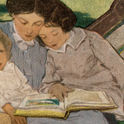In Villahermosa in southern Mexico—in an archaeological park that is disconcertingly paired with a zoo—stands a colossal severed head. It is a couple of metres high and made from basalt, one of seventeen or so such heads produced some 3,000 years ago by the earliest known civilisation in central America. We now call this civilisation “the Olmec,” but the name dates from the Aztec period, a millennium or more later. What they called themselves we have no clue.
What the heads were—what they were for—is just as much of a mystery. What do they represent: human beings or gods? Are they portraits, or something else? We know that the stone used to make them came from miles away from where the heads were first displayed, and furthermore that they were created using nothing more than stone tools. Who invested such vast resources—and what was their motive? What was on show here, and why? And what did the people who first saw the heads make of them? The Olmec, whoever they were, aren’t much help: no written record survives.
These questions are fascinating because the Olmec heads are so different to what we in the modern west often regard as “beautiful” or “naturalistic.” They prod at our certainties, reminding us how narrow and restrictive that vision is. When it comes to images of the human form, from fashion designs to films to advertising and pornography, we are heirs to one particular version of the body that was invented around the turn of the 6th and 5th centuries BC.
It was at that point that the stiff, plank-like sculptures of the so-called archaic period of Greece gave way to the lithe, subtle, mobile images of the body with which we have become familiar. We see these figures on the frieze of the Parthenon, and in the famous bronze of Poseidon apparently throwing his trident into the waters, now in the National Archaeological Museum in Athens. (The change happened a little earlier in the paintings on Greek ceramics.)t
What drove this shift is one of the great puzzles of art history. Some have fantasised that the rise of democracy, and the new respect for the individual supposed to go with it, was responsible—a nice thought, although sadly the theory doesn’t really fit. (Athenian democracy came later, and in any case similar artistic developments are found in Greek cities that never flirted with democracy.) The celebrated art historian EH Gombrich, in his classic Art and Illusion from 1960, tried to connect it to the Greek impulse for narrative and storytelling.
*** Whatever the answer, we still struggle to escape the straitjacket of those bodies. Since the 18th century, they have been seen as the acme not just of art, but of “civilisation” itself—a version of artistic naturalism that has forged a dominant way of seeing. They have even coloured judgments of artistic traditions other than our own. Think of the Benin bronzes, created in the 14th century in what is now Nigeria: they have become famous and admired in the west at least partly because they seem to have echoes of Greek classical form, but with an enticing hint of otherness. The less of that classical tradition we can detect, the more “primitive” the art is deemed to be.
Yet it is time to think afresh about these questions: to ask what we really mean by the term “civilised.” For Kenneth Clark, who wrote and presented the seminal BBC documentary series Civilisation, the concept was rooted in the Greek ideal. Searching for a definition early on in the very first programme, he suggested with patrician certainty that “I can recognise it when I see it.” With Simon Schama and David Olusoga, I’ve taken up the challenge of responding.
Our BBC series is called Civilisations, with a defiant plural: not one kind of civilisation, but many. And there is a bigger question here about what we think civilisation might be. Who’s the barbarian? Could it even be us?
In the second episode of the new series, “How Do We Look,” we focus on bodies in particular, trying to broaden our awareness of early representations of the human form—charting not only the ways that representation evolves, but also the evolving ways the body was seen. We have tried to recapture the surprise—the “shock of the new,” as Robert Hughes put it in another well-known television series—that some of these now-classic images of the body must once have provoked. What, for example, was it like, in the 4th century BC, to witness the first life-size nude statues of women ever made in the west?
One of the most telling examples is found near modern Luxor, on a massive statue originally commemorating Pharaoh Amenhotep III, who lived in the 14th century BC. A millennium and a half after it was finished, in 130AD, the Roman emperor Hadrian came to see it. The statue had been damaged some time before, which apparently caused it to make whistling sounds or “sing” at daybreak. Among Hadrian’s entourage was a lady-in-waiting, who came out one day at dawn with the imperial party to witness this Roman tourist attraction.
Mysteriously, the statue failed to do his party piece; it wasn’t until a few days later, when they made another visit, that any sound emerged. Julia recorded her experience in a poem (in what is admittedly some dreadful doggerel) inscribed on the monument’s leg: some of the earliest snatches of art criticism to survive.
Other observers were more suspicious, noted the Greek travel writer Pausanias, suggesting that there were some boys around the back with an out-of-tune lyre.
These inscriptions are interesting not merely because of the story, but because they provoke wider questions about the function of early images of the body. All too often, we think of ancient art as something passive rather than active: something that lines the walls of modern museums and galleries, and which it’s easy to glide past without really noticing. But many ancient sculptures and portraits did much more than that.
Some, for example, commemorated the dead; but many brought the living presence of the lost into the contemporary world. The famous terracotta warriors buried with the first emperor of China in the 3rd century BC were in some sense a real army, prepared to protect their leader in his underground empire. Ancient images did things.
*** Why do such questions matter? Because we are, I think, still living with their legacy. Just as Ancient Greek art held up an impossibly ideal image of beauty to its viewers, the kalos kai agathos—the man who was both beautiful and virtuous—so we in the modern world grapple with the idealised images of advertising and the movies, animations and music videos. We worry what it is to “look good.”
In many ways, there is little to connect the idealised images of the human body found in the ancient Greek world and those with which we now live. But it is here we can see at its clearest the origins of the western body beautiful—something we admire, but which also haunts us. And it is here that we can see the template of beauty that has excluded other ethnicities, colours, shapes and sizes. The western tyranny of body image started here.
Which is why I find that vast and strange Olmec head not just puzzling and destabilising, but uplifting. We can never get inside the Olmecs’ skin, or their way of seeing. But maybe confronting a proud parade of body images so very different from the ones we usually glimpse is a way to face up to the question of how we look—or should.












